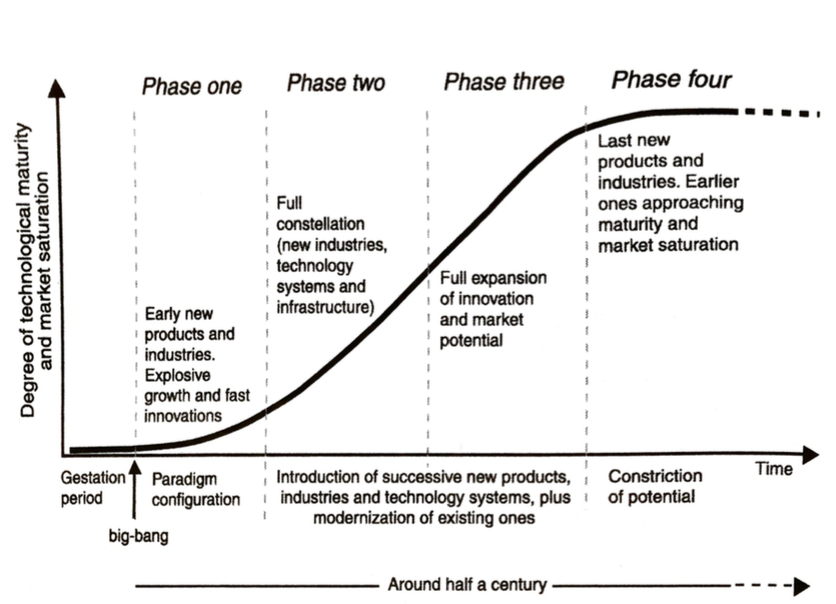The End Of Employment: The Emerging Economic Structure Of Networked Entrepreneurial Businesses.
The existing socio-political framework is a backward-looking structure that evolved to protect the economic arrangements of a bygone age. It’s no longer useful, and gets in the way of progress.
We can take socio-political framework to mean the accepted way of doing things, the accepted social and political arrangements under which we all live and about which we don’t think too much. Big government, big corporations, employment, the welfare state for those who aren’t employed, government-run education, physical infrastructure, central banks, Wall street and its associated financial architecture. All of these grew up to support the industrial-age economy of manufacturing, economies of scale, trade in physical goods between countries, and the financial engineering required to actualize them.
In Carlotta Perez’s monumental book Technological Revolutions And Financial Capital the author points out that technological revolutions (such as the Victorian Industrial Age or the internet technology and communications revolution of the end of the 20th Century) precede social and political change. Entrepreneurs and innovators discover new ways to create value for customers and users, and people happily adopt these new ways. Only afterwards do politicians recognize the change and rush in to promise to “protect” their voters from exploitation by the new industries. Only afterwards do we get anti-trust laws and the SEC and labor relations laws and OSHA and new layers of the welfare state.
The new political rules are not only for the benefit of parasitical politicians. By the time the politicians have woken up to the availability of their new opportunity to regulate and tax, there are already incumbents who have emerged from the technological revolution. In the early part of the 20th century, it was the big steel, railroad and manufacturing companies. In the middle of the century, it was the big auto companies and durable and industrial goods manufacturers. In the last part of the century, it was the big banks and financial companies and energy companies. Today, it’s the big digital companies, and healthcare. They got big and, once established, they worked with politicians for the socio-political framework to protect their incumbency and discourage or exclude innovative startups and revolutionaries.
In this way, according to Professor Perez, a self-perpetuating ecosystem evolves, linking government, institutions, technology, corporate forms, financial engineering, and the legal system, in order to support and preserve the status quo. What started in innovation coalesces into preservation. She traces several cycles of this type in the last few hundred years of economic and social history.

The other half of Professor Perez’s story is that, just as the new order is cementing itself in place, the next revolution is starting. On the fringes, and in the very early stages, experimentally-oriented entrepreneurs who are not associated with the incumbency are trying out new ideas and launching new initiatives. On the blockchain, on new technology platforms, and within new networks, some of them cyber-protected from external view, these ideas and initiatives will be tested, adapted, revised, renewed and, eventually, scaled. Some will succeed, some will fail, and there will be an accelerated learning that fuels the early phase of a new techno-economic S-curve cycle. What’s harder to predict, according to Prof Perez, is how the new socio-political framework will emerge, because it is a lagging phenomenon. We can’t predict, but we can surmise about what institutional replacements will be made in the next cycle phase.
The end of scale
Big government, big corporations, big finance, big data. The sclerosis of the current socio-political and techno-economic structures is exacerbated by the once-prized but now disdained properties of scale. The theory of economics of scale was a product of the industrial age. Entrepreneurs like Andrew Carnegie built giant manufacturing companies and economists, following dutifully behind, observed cost efficiencies and wrapped a theory around them. Today neither the centralized manufacturing process, the size of the company, nor the concentration of physical capital are required. The network has replaced the monopoly, and whatever efficiencies are to be found lie in connections, speed, and agility. “Big” is no longer relevant or necessary.
The end of financial engineering.
One of the many insights of Prof Perez’s book is the role of finance in the beginning and the end of the S-curve of technological revolutions. In the entrepreneurial beginnings at the bottom of the curve, the role for finance is experimental. Angel investors, seed-stage investors, and venture capitalists of the individualistic rather than institutionalized sort make capital available to the explorers and tinkerers. Some of these investments pay off and many don’t. Prof Perez calls this experimental function financial capital.
She contrasts that to production capital, which is the institutionalized capital-at-scale that arrives at the later stage of the cycle to cement the winners in place and make a return from their incumbency and their exploitation of their position in established markets. Yes, there is still innovation, but much of it is incremental and is processing, marketing or organizational innovation based on already-proven technology, rather than new or radical technological innovation. It’s what we can call financial engineering – including M&A, stock buybacks, and other forms of returns-gathering from activities that are not necessarily aimed at producing new value for consumers and customers.
Today, the emerging, networked, agile experimental corporations don’t seek financial engineering for scale. There are many ways to network into capital as needed, there’s a whole new emerging industry of fintech, and the fee-burdened financial engineering of the oligopolistic Wall Street banks and funds is eschewed as unnecessary and unnecessarily expensive and exploitative.
The end of employment.
John Maynard Keynes’s civilizational-destroying book was called The General Theory Of Employment, Interest, and Money. Employment was central to economists’ thinking back then because the giant industrial corporations had a need for masses of workers capable of performing repetitive routinized jobs. When the giant machine of finance-fixed capital – manufacturing – jobs fell out of equilibrium, employment was the first to go. At that point, governments became burdened with the problem of a disgruntled “labor force” who concocted welfare demands as their response to the dislocation of their employment. At this point, the maintenance of employment had become the very point of the economic and social framework.
In the coming digital age, employment is not the point. It’s replaced by entrepreneurship. In the networked world, every individual has unique knowledge and skills that are traceable with others, and each one of them will identify their individual entrepreneurial advantage. It might take the form of buying and selling, or of contracting for services, or gig work, or art and entertainment, but it won’t be “employment”. Jobs are not a staple of the entrepreneurial age.
The End Of Big Education
Big education emerged in the old socio-political framework to populate the employment pyramid. Government schools turned out the compliant workers for the routinized jobs of the big corporations. Community colleges provided the skilled work ad middle management layers. And the 4-year universities populated the executive levels. It was a well-functioning system, but became corrupted at the top of the S-curve, as is normal. The government K-12 schools are the most decayed, and no longer provide any valuable contribution. The other layers are similarly compromised.
The new forms are already emerging: home schooling, private schools of various kinds, online education, digital badging and certification. An enterprising entrepreneur can assemble their own educational components to give themselves the learning, skill acquisition and continuous improvement that they need for their own custom path.
Private currency
The financial system that evolved to support the big government-big business framework included the gold standard (until 1971) and the complex of national currencies created out of thin air – “printed” – by central banks. Today it’s called fiat money (and its ascent and decline are entertainingly documented by Saifedean Ammous in his latest book, The Fiat Standard).
Crypto currency, a private alternative to government fiat currency, is just now at the very beginning of its emergence at the bottom of the S-curve. It’s significant because it replaces one of the most fundamental building blocks in the socio-political framework, and that’s money. More specifically, it shifts control of money from governments to private individuals and private institutions. It’s part of the entrepreneurial revolution.
Austrian economics
The institutional binding that ties the new elements together in the novel socio-political and technological-economic frameworks is Austrian economics. The mainstream economics of today – often called neo-classical economics by the folks in academia – was compiled in support of all the big government-big business structures listed here. Its theories support government-printed money, government intervention in economic matters to subsidize employment, the legal and financial systems to support big business, large scale financial engineering, and the welfare state.
Austrian economics is the term the academicians give to the opposite way of thinking, economically speaking. Austrian economic theory is centered on universal entrepreneurship and the human value it creates. It is an economics of networks and systems, not of scale, and of individual human contribution to value, rather than “jobs”. It’s comfortable with private, competing monies, and with a stripped down legal framework that is “laissez-faire” rather than prescriptive and controlling. It’s the economics of entrepreneurship, and of the internet and value networks. It’s the economics for the coming entrepreneurial age.


Leave a Reply
Want to join the discussion?Feel free to contribute!